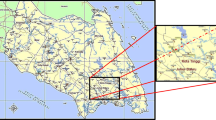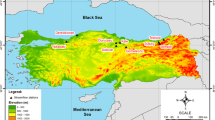Abstract
The presence of storage and water conservation structures significantly influences the characteristics of hydrologic time series. This paper first analyzes the daily streamflow and total suspended sediment (TSS) concentration of the Kallada River in southern Kerala, India using continuous wavelet transform (CWT). The wavelet power spectra of streamflow displayed a complete removal of annual periodicity since ~ 2002–2003 period, and the wavelet coherence analysis confirmed the effect of human interventions on hydrological variability of the Kallada River. The study further confirmed the direct influence of reduction in precipitation on the variability of streamflow and the impact of hydrologic regulations and human interventions on the variability of TSS concentration of the Kallada River. Further, both of the hydrologic series were analyzed using multifractal detrended fluctuation analysis (MFDFA) for its fractal characterizations, after splitting the series to pre and post 2002–2003 period. MFDFA analysis showed that both streamflow and TSS data possess long-term persistence with Hurst exponent varying between 0.74–0.99 for different series. It is further noticed that multifractal degree of the TSS concentration series is greater than that for streamflow in all cases. The MFDFA analysis displayed a reduction in the intercept of the fitted fluctuation function plots of streamflow and TSS concentration series of the Kallada River. The degree of multifractality of both streamflow and TSS concentration series of post 2002–2003 period is reduced by 26% and 82% respectively over the corresponding series of pre 2002–2003 period. The study implied the effect of hydrologic regulations by the water conservation reservoirs of the Kallada basin on the hydrologic variability of the river.












Similar content being viewed by others
Abbreviations
- ∣W(τ, s)∣:
-
Amplitude of wavelet fucntion
- ω o :
-
Dimensionless angular frequency
- ∣W XY∣:
-
Cross-wavelet power
- f(α):
-
Singularity spectrum
- F q(s):
-
q order fluctuation function
- H :
-
Hurst exponent
- h(q):
-
Generalized Hurst exponent
- k :
-
Fourier frequency index
- \( \overline{x} \) :
-
Mean of the time series
- ψ o(η):
-
Morlet wavelet function with dimensionless parameter η
- ψ(t) :
-
Mother wavelet
- N :
-
Length of the time series
- ψ τ, s(t):
-
Normalized scaled and translated wavelet function, and τ is the translation factor
- N s :
-
Number of non-overlapping segements
- P k X and P k Y :
-
Background power spectra of series X and Y
- q :
-
Moment order
- s :
-
Scale or segment sample size in MFDFA analysis
- s o :
-
Smallest scale in Morlet wavelet
- u(t):
-
Progressive series
- u’(t):
-
Retrograde series
- W n XY :
-
Cross-wavelet transform between time series series X and Y
- X(t):
-
Time series
- Y i(t):
-
Profile of the time series
- y υ(i):
-
Fitting polynominal in segment υ
- α :
-
Sigularity expoenent
- δ j :
-
Scale step size in wavelet
- σ X 2, σ Y 2 :
-
Variance of the series X and Y
- τ(q):
-
q-order mass exponent
References
Zhang Q, Cu C-Y, Chen YD, Yu Z (2008) Multifractal detrended fluctuation analysis of streamflow series of the Yangtze river basin, China. Hydrol Process 22:4997–5003
Zhang Q, Chen G, Su B, Disse M, Jiang T, Xu C-Y (2008) Periodicity of sediment load and runoff in the Yangtze river basin and possible impacts of climatic changes and human activities. Hydrol Sci J 53(2):457–464
Zhang Q, Xu C-Y, Yu ZG, Liu C-L, Chen Y (2009) Multifractal analysis of streamflow records of the East River basin (Pearl River), China. Physica A 388:927–934
Yu Z, Zhang Q, Singh VP (2014) Fractal-based evaluation of the effect of water reservoirs on hydrological processes: the dams in the Yangtze River as a case study. Stoch Env Res Risk A 28:263–279
Li E, Mu X, Zhao G, Gao P (2015) Multifractal detrended fluctuation analysis of streamflow in the Yellow River basin, China. Water 7:1670–1686
Kuai KZ, Tsai CW (2012) Identification of varying time scales in sediment transport using the Hilbert–Huang transform method. J Hydrol 420–421(2012):245–254
Adarsh S, Janga Reddy M (2016) Multiscale characterization of streamflow and suspended sediment concentration data using Hilbert–Huang transform and time dependent intrinsic correlation analysis. Model Earth Syst Environ 2:1–17. https://doi.org/10.1007/s40808-016-0254-z
Anctil F, Coulibali P (2004) Wavelet analysis of the inter-annual variability in Southern Quebec streamflow. J Clim 17:163–173
Coulibali P, Burn DH (2004) Wavelet analysis of variability in annual Canadian streamflows. Water Resour Res 03(/2004):40. https://doi.org/10.1029/2003WR002667
Labat D (2005) Recent advances in wavelet analyses: part 1. A review of concepts. J Hydrol 314:275–288
Partal T (2009) Wavelet transform-based analysis of periodicities and trends of Sakarya basin (Turkey) streamflow data. River Res Appl 26(6):695–711
Massei N, Laignel B, Deloffre J, Mesquita M, Motelay A, Lafite R, Durand A (2010) Long-term hydrological changes of the Seine river flow (France) and their relation to the North Atlantic Oscillation over the period 1950–2008. Int J Climatol 30:2146–2154
Rashid MM, Beecham S, Chowdhury RK (2015) Assessment of trends in point rainfall using continuous wavelet transforms. Adv Water Resour 82:1–15
Rashid MM, Beecham S, Chowdhury RK (2016) Statistical downscaling of rainfall: a non-stationary and multi-resolution approach. Theor Appl Climatol 124(3–4):919–933
Yang P, Xia J, Zhang Y, Hong-Si (2017) Temporal and spatial variations of precipitation in Northwest China during 1960–2013. Atmos Res 183:283–295
Jemai S, Ellouze M, Abida H (2017) Variability of precipitation in arid climates using the wavelet approach: case study of watershed of Gabes in south-east Tunisia. Atmosphere 8(9):178
Zhang Q, Chong-yu X, Jiang T, Wu Y (2007) Possible influence of ENSO on annual maximum streamflow of the Yangtze River, China. J Hydrol 333:265–274
Niu J, Chen J, Sivakumar B (2014) Teleconnection analysis of runoff and soil moisture over the Pearl River basin in southern China. Hydrol Earth Syst Sci 18:1475–1492
Rashid MM, Beecham S, Chowdhury RK (2014) Influence of climate drivers on variability and trends in seasonal rainfall in the Onkaparinga catchment in South Australia: a wavelet approach. In 13th International Conference on Urban Drainage, Sarawak, Malaysia, 7–12 September 2014
Araghi A, Mousavi-Baygi M, Adamowski J, Martinez C (2017) Association between three prominent climatic teleconnections and precipitation in Iran using wavelet coherence. Int J Climatol 37(6):2809–2830
Özger M, Mishra AK, Singh VP (2009) Low frequency drought variability associated with climate indices. J Hydrol 364(1):152–162
Huang S, Huang Q, Chang J, Leng G (2016) Linkages between hydrological drought, climate indices and human activities: a case study in the Columbia River basin. Int J Climatol 36(1):280–290
Rashid MM, Johnson F, Sharma A (2018) Identifying sustained drought anomalies in hydrological records: a wavelet approach. J Geophys Res Atmos 123(14):7416–7432
White MA, Schmidt JC, Topping DJ (2005) Application of wavelet analysis for monitoring the hydrologic effects of dam operation: Glen Canyon Dam and the Colorado river at lees ferry, Arizona. River Res Appl 21:551–565
Rossi A, Massei N, Laignel B, Sebag D, Copard Y (2009) The response of the Mississippi River to climate fluctuations and reservoir construction as indicated by wavelet analysis of streamflow and suspended-sediment load, 1950–1975. J Hydrol 377(3–4):237–244
Zhao G, Mu X, Strehmel A, Tian P (2014) Temporal variation of streamflow, sediment load and their relationship in the Yellow River Basin, China. PLoS One 9(3):e91048. https://doi.org/10.1371/journal.pone.0091048
Tessier Y, Lovejoy S, Hubert P, Schertzer D, Pecknold S (1996) Multifractal analysis and modeling of rainfall and river flows and scaling causal transfer functions. J Geophys Res 101(D21):26427–26440
Pandey G, Lovejoy S, Schertzer D (1998) Multifractal analysis of daily river flows including extremes for basins of five to two million square kilometres, one day to 75 years. J Hydrol 208(1–2):62–81
Dahlstedt K, Jensen H (2005) Fluctuation spectrum and size scaling of river flow and level. Physica A 348:596–610
Kantelhardt JW, Zschiegner WSA, Koscielny-Bunde E, Havlin S, Bunde A, Stanley HE (2002) Multifractal detrended fluctuation analysis of non-stationary time series. Physica A 316:87–114
Kantelhardt JW, Rybski D, Zschiegner SA, Braun P, Koscielny-Bunde E, Livina V, Havlin S, Bunde A (2003) Multifractality of river runoff and precipitation: comparison of fluctuation analysis and wavelet methods. Physica A 330:240–245
Kantelhardt JW, Koscielny-Bunde E, Rybski D, Braun P, Bunde A, Havlin S (2006) Long-term persistence and multifractality of precipitation and river runoff records. J Geophys Res 111:D01106. https://doi.org/10.1029/2005JD005881
Bunde KE, Kantelhardt JW, Braun P, Bunde A, Havlin S (2006) Long-term persistence and multifractality of river runoff records: detrended fluctuation studies. J Hydrol 322:120–137
Torrence C, Compo GP (1998) A practical guide to wavelet analysis. Bull Am Meteorol Soc 79(1):61–78
Grinsted A, Moore JC, Jevrejeva S (2004) Application of the cross wavelet transform and wavelet coherence to geophysical time series. Nonlinear Process Geophys 11(5/6):561–566
Burrus C, Gopinath R, Guo H (1998) Introduction to wavelets and wavelet transforms. Prentice Hall, New Jersey
Peng C-K, Buldyrev SV, Havlin S, Simons M, Stanley HE, Goldberger AL (1994) Mosaic organization of DNA nucleotides. Phys Rev E 49:1685–1689
Hurst HE (1965) Long-term storage : an experimental study. Constable, London
Hurst HE (1951) Long-term storage capacity of reservoirs. Trans Am Soc Civ Eng 116:770–808
Ihlen EA (2012) Introduction to multifractal detrended fluctuation analysis in MATLAB. Front Physiol 3:1–19
Hajian S, Movahed MS (2010) Multifractal detrended cross-correlation analysis of sunspot numbers and river flow fluctuations. Physica A 389(2010):4942–4954
Mann HB (1945) Nonparametric tests against trend. Econ J Econ Soc 13:245–259
Kendall MG (1975) Rank correlation methods. Griffin, London
Sneyers R (1991) On the statistical analysis of series of observations. World Meteorological Organization. Technical note 143, Geneva, Switzerland
Adarsh S, Janga Reddy M (2015) Trend analysis of rainfall in four meteorological subdivisions in southern India using non-parametric methods and discrete wavelet transforms. Int J Climatol 35(6):1107–1124
NRSC (2012) Assessment of irrigation potential created in AIBP funded 50 irrigation projects in India using Cartosat satellite data (phase-II) –a report on Kallada irrigation project submitted to central water commission India. NRSC-RSAA-WRG-AIBP50-Sept 2012-TR-441
Bassingthwaighte JB, Raymond GM (1995) Evaluation of the dispersional analysis method for fractal time series. Ann Biomed Eng 23(4):491–505
Bassingthwaighte JB, Beyer RP (1991) Fractal correlation in heterogeneous systems. Physica D 53:71–84
John E (2009) The impact of sand mining in Kallada River (Pathanapuram Taluk) Kerala. J Basic Appl Biol 3(1–2):108–113
Author information
Authors and Affiliations
Corresponding author
Rights and permissions
About this article
Cite this article
Adarsh, S., Dharan, S.D. & Anuja, P.K. Analyzing the Hydrologic Variability of Kallada River, India Using Continuous Wavelet Transform and Fractal Theory. Water Conserv Sci Eng 3, 305–319 (2018). https://doi.org/10.1007/s41101-018-0060-8
Received:
Revised:
Accepted:
Published:
Issue Date:
DOI: https://doi.org/10.1007/s41101-018-0060-8




